THE BEGINNING
1840S-1850S THE BEGINNING
In 1844, industrialized London is a place of great turmoil and despair. Disturbed by this, twenty-two-year-old George Williams, alongside 11 friends, creates the first Young Men’s Christian Association (YMCA) as a place to give refuge to young men escaping the hazards of London life. The organization’s drive to meet social need in the community is compelling, and its openness to members crossed the rigid lines separating English social classes.
Throughout the 1840s and 1850s the first YMCAs are established in Canada and North America which leads to the establishment of the first Student YMCA at the University in Lebanon, Tennessee. The 1850s also marks the start of educational courses such as the nation’s first-recorded English as a Second Language (ESL) courses offered by the YMCA in Cincinnati, Ohio.
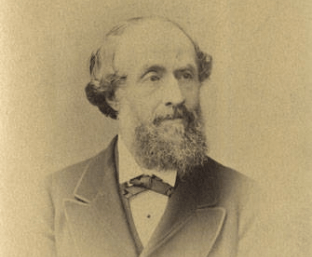
Sir George Williams, c. 1876
In recognition of his contribution to English society and the world, Williams was knighted by Queen Victoria in 1894. After his death in 1905, he was commemorated by a stained-glass window in the nave of Westminster Abbey and buried in St. Paul’s Cathedral.
1860S
The 1860s marks the YMCA’s first war relief efforts, the start of YMCA Housing, and entrances into boys’ youth work including the first Black Student YMCA, at Howard University. President Abraham Lincoln recruits over 5,000 YMCA volunteers from the U.S. Christian Commission to serve as surgeons, nurses, and chaplains during the American Civil War, distributing medical supplies, food, clothing, and teaching soldiers to read and write.
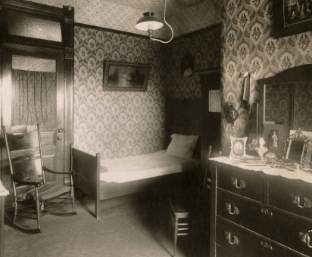
Example of YMCA Housing.
Starting in the 1860s these hotel-like rooms gave young men moving from rural areas safe and affordable lodging in the city.
Courtesy of YMCA of the USA
1870S
The YMCA has a long history of being the first to establish organizations for minority groups. In San Francisco, the First Chinese-American YMCA, alongside YMCAs serving Asian communities, are established in 1875 to serve the city’s expanding Chinese population.
The first Sioux Indian YMCA is organized in 1879 in the Dakota Territory by Thomas Wakeman, son of Chief Little Crow. Work among Native-American young men and boys is carried out in the areas of education, health, public sanitation, employment, leadership development, and Christian education. The number grows to 66 Sioux associations with more than 1,000 members. In addition, YMCA work is carried out with other tribes across the U.S.
This time period also establishes the first Railroad YMCA, student work as a permanent part of the International Committee, and a women’s private school that eventually leads to college summer conferences, the student volunteer movement, and the American YMCA’s foreign work, eventually called YMCA World Service.
YMCA’s School for Christian Workers, now Springfield College, opens and, through the turn of the 20th century, would be the only training center and innovator of physical education in the country.
Camping became a cornerstone of YMCA programming in 1885, when the YMCA opened America’s first known summer camp, Camp Dudley, at Orange Lake, New York.
YMCA’s School for Christian Workers changes its name to YMCA Training School.
High-school YMCA clubs, called Hi-Y, are founded. Later the National Hi-Y Fellowship is formed to, “create, maintain, and extend throughout the school high standards of Christian character.”
Amos Alonzo Stagg, Graduate Class of 1891, introduces football at the College. Later known as the “Grand Old Man of Football,” he captains the College’s first baseball team and invents the indoor batting cage, football hip pads, cleats, and many football plays and strategies.
Luther H. Gulick, M.D., who revolutionized sports and physical fitness at the YMCA’s Springfield College, incorporated in 1891 as the International YMCA Training School, proposes the Gulick triangle. According to Gulick, the triangle would stand for “man’s essential unity, body, mind, and spirit, each being a necessary and eternal part of man, he being neither one alone…”
In December 1891, Dr. Gulick gives physical education teacher James Naismith two weeks to come up with an indoor winter game to challenge a class of future Y directors. Naismith hangs peach baskets to the bottom of a second-level running track and teaches the men his new game: basketball. Today, basketball is second only to soccer as the most popular sport in the world.
East Gymnasium, the first building on the Alden Street campus, is built. Later additions of West Gymnasium, McCurdy Pool, and a renaming transform it into the structure known as Judd Gymnasia.
England’s Queen Victoria knights YMCA founder George Williams on the 50th anniversary of the Y’s founding.
Recording of Sir George Williams Speech to the Jubilee Class of 1894
YMCA instructor William Morgan considers basketball too strenuous for businessmen, so he blends elements of the game with tennis and handball and calls his invention “mintonette.” In 1896, at the International YMCA Training School in Springfield, Massachusetts, the name “volley ball” is first used to describe the back-and-forth manner in which the ball flies over the net. Today, more than 46 million Americans play volleyball.
The College’s Administration Building is built, allowing students to live on the campus for the first time in 1896. Each student is asked to raise the cost of furnishing one room. ($30)
Laurence Locke Doggett becomes the first full-time president of the College, and remains so for 40 years. He wants physical education to mean “truth, beauty, goodness”… because “these three belonged together.”
TURN OF THE CENTURY
1900S-1910S TURN OF THE CENTURY
Stepping into the 20th Century, the YMCA movement continues to establish many firsts. This includes influential military firsts with the creation of 14 Army-Navy YMCAs funded by U.S. Congress and the establishment of the Army and Navy Department during the Spanish-American War. YMCA for Coal Miners is founded alongside the creation of the YMCA Industrial department and the Silver Bay training center for missionaries, foreign work staff, and church leaders.
As the YMCA continues its focus on education, William H.J. Beckett receives the first degree ever awarded by the College, a Bachelor of Humanics. A year later, the YMCA movement establishes the Association Press to share information and expertise among Ys and to publish books “which contribute to the making of Christian character.”
Towards the end of the 1910s, the YMCA reaches major youth work milestones. National boy’s work secretary, Edgar Robinson, works with two Englishmen to found the Boy Scouts of America. At the same time, the College’s president and YMCA leader, Dr. Luther Gulick, and his wife, Charlotte, founded the Camp Fire Girls, as the sister organization to the Boy Scouts of America.
“The thing I like about you YMCA folks is the way you mix religion and common sense.”
The First World War
The YMCA dispatched 26,000 men and women to minister to the mental, spiritual, and physical needs of the U.S. military and its allies serving on the front lines and behind the scenes during WWI. President Taft called the YMCA’s work…”one of the greatest achievements of peace in all the history of human warfare.”
WWI marked a turning point for the YMCA. The success of its work validated its approach to holistic development in addition to introducing the YMCA to millions of individuals who benefited from its programs for the first time.
John Ma graduates from Springfield College. He goes on to become the first director of the All-China Sports Federation and is commonly known as China’s “Father of Physical Education.”
John D. Rockefeller Jr. donates $1 million to start the YMCA Retirement Fund.
Lake Massasoit campsite is purchased (now East Campus). Camp Massasoit opens six years later.
The Great Depression in the US results in major budget reductions affecting YMCA work in other countries.
Father of Modern Dance in the United States, Ted Shawn, H’36, teaches at Springfield College and later founds Jacob’s Pillow.
National Council votes that each association may determine qualifications for membership and boards.
Women are formally recognized and admitted to the Association of Secretaries.
Basketball is introduced as an official sport at the Berlin Olympics. Naismith reports upon his return that numerous Olympic basketball teams are coached by Springfield College graduates.
WAR RELIEF EFFORTS
1940S-1950S WAR RELIEF EFFORTS
The YMCA movement has a long history of aiding in war relief efforts from raising money to helping serve troops, and World War II is no exception. The YMCA, along with five other national voluntary organizations, founds the United Service Organizations for National Defense, today known as the USO. During this time, YMCA staff secretly work inside U.S. internment camps that held 110,000 Japanese Americans to organize clubs and activities for children. This time also leads to twenty-six former prisoners of war, from six states and nine cities, to meet at the West Side YMCA in NYC and organize the International Association of Barbed Wire Clubs.
In 1950, YMCA volunteer Joe Sobek invents racquetball in Greenwich, Connecticut, as an alternative to squash and handball. Like previous YMCA inventors, Sobek is not paid for his invention; he bestows it as a gift to all who play the game – then and now.
From 1956 into the 1960s, the YMCA Building for Brotherhood campaign raises more than $5.5 million to strengthen the infrastructure of many YMCA national organizations and establishes a Y presence in several countries around the world.
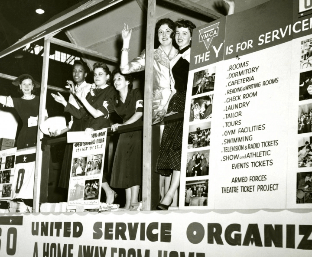
YMCA Co-Founds United Service Organization (USO)
During World War II, the YMCA, along with five other national voluntary organizations, founded the United Service Organizations for National Defense, today known as the USO.
Courtesy of YMCA of the USA
President John F. Kennedy founds Peace Corps, patterned after the YMCA World Service which started in the 1880s.
Administration of the Springfield College Women’s Athletic Program officially begins, 10 years before Title IX, with the inaugural seasons for field hockey, tennis, softball, and basketball following in 1963.
Springfield College is prominently featured in the December 2 issue of Sports Illustrated as a school that “is making an unequaled contribution to American sports.”
The Rev. Martin Luther King Jr., gives the commencement address and receives an honorary doctorate on June 14, despite outside attempts to persuade the College to rescind its invitation to King.
YMCA creates and trademarks Dr. Gulick’s red triangle.
Racial discrimination is banned in YMCAs.
The James Naismith Memorial Basketball Hall of Fame opens on the Springfield College campus.
YMCA youth soccer leagues are developed.
Jazzercise, invented by dancer Judi Missett, debuts at the McGraw YMCA in Evanston, Illinois. A year later, Jackie Sorenson begins “dance exercise” classes, leading to the boom in “aerobics” in the United States and Canada.
“Through programs of study, group participants and religious devotions, the YMCA has played an important role in shaping our national character. And, in doing so, it has consistently recognized the relationship of physical vigor to responsible citizenship.”
Attorney General of the United States
Journal of Physical Education
“The YMCA, as much as any other institution, has a record of working on desegregation. The only place you could meet in the South in the ’50s, blacks and whites together, was the YMCA camp in North Carolina.”
YMCA Alumnus, Dryades YMCA,
New Orleans
1970S
The beginning of the 1970s marks the continuation of mentoring and serving youth. Dr. Leo B. Marsh starts the Black Achievers program at the Harlem Branch YMCA in New York. The program links adult volunteer mentors with youth. The National Y Program Using Minibikes (NYPUM) is established by Fred Hoshiyama as a national YMCA program. It is designed primarily for “adjudicated youth,” those who were apprehended and convicted by the court system. The Honda Motor Company contributes the minibikes for the program.
In the mid-1970s, the national YMCA and the NBA Players Association creates the Youth Basketball Association (YBA) to organize sports programs for young people that emphasize skills and teamwork over winning. Continuing the Y’s impact in swimming, the National YMCA Swimming and Diving Championship, with 1,500 participants, becomes the largest swimming championship in the world.
FAMILIES AND HEROES
1980S FAMILIES AND HEROES
The 1980s provides great reflection and admiration for those who have contributed to the YMCA movement. The rich heritage of the YMCA encompasses leaders who set new standards in their own YMCAs and communities, who influence Y work nationally and internationally, and who set a standard of excellence and achievement for generations of Y leaders to come. In 1985 the National YMCA Hall of Fame is established at Springfield College and recognizes the significant accomplishments and influence of the unique contributors to the Y Movement. The first two inductees are Herbert P. Lansdale, Jr., and Paul Moyer Limbert. In 1988, the First YMCA General Assembly is held in Boston and hosts the induction ceremonies for heroes selected to be in the Hall of Fame.
The 1980s also mark a pivotal time for the YMCA movement serving local communities. Throughout the 1980s and ’90s, a surge of Baby Boomers with families become members of the YMCA. The Y responds by creating new programs like family swims and family nights, providing families with opportunities to play, interact, and have fun together. Alongside this, Tom Waddell, M.D., ’59 founds the Gay Games, a quadrennial arts and athletic event open to anyone who would like to participate, 14 years after he competes in the decathlon for the United States in the Mexico City Olympics.
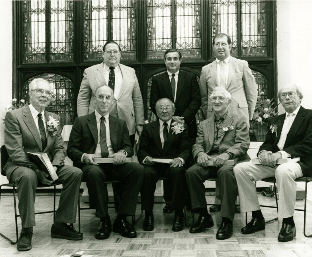
This photograph shows the five inductees to the 1989 YMCA Hall of Fame in the front row including (from left to right) John H. Dunderdale, William A. Howes Jr. (accepting the award for his father), Fred Y. Hoshiyama, Donald S. Hayward, and John O. Root. The back row shows Frank S. Falcone (the tenth president of Springfield College) and two men associated with the induction ceremony. The ceremony took place on June 17, 1989.
FAMILIES AND HEROES
1990S FAMILIES AND HEROES
The 1990s mark a decade of reform for the YMCA movement. YMCA of the USA first begins work on public policy issues in the late 1970s and in 1991 forms the Government Relations and Public Policy Office in the nation’s capital. This office champions the YMCA mission with lawmakers and officials. The office also works with YMCAs and YMCA state alliances to strengthen their government relations efforts, helping them advocate for the kids, families, and communities they serve and deepening their influence in state capitals. During this time, YMCAs also create the Character Development thrust in response to declining morality and lack of values education. The YMCA movement, celebrating a rich history in character development, formally defines character as the demonstration of four core values: caring, honesty, respect, and responsibility. This time allows for the Y to focus on the arts as well and to formally adopt one logo and the theme, “We build strong kids, strong families, and strong communities.”
Springfield College pushes forward as they amend their charter to grant master’s degrees in social work. The college’s athletics move from Division II to Division III and their nickname changes from the Chiefs to the Pride. Humanics in Action Day, an annual day of community service throughout the city of Springfield initiated by Distinguished Springfield Professor of Humanics Peter Polito, first takes place. Today, the event generates more than 100 service projects each year at schools, churches, senior citizen facilities, and neighborhoods in Springfield and in the areas surrounding our regional campuses.
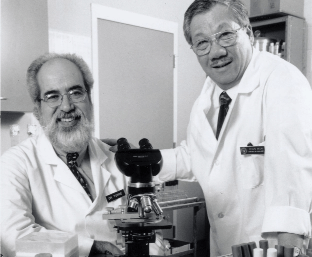
Springfield College chemistry professors Chun-Kwun Won and Frank Torre help develop a rapid test that can detect killer E. coli bacteria before tainted food, such as hamburger, leaves warehouses on its way to consumers.
21ST CENTURY RESPONSE TEAM
2000S 21ST CENTURY RESPONSE TEAM
The turn of the 21st Century for the YMCA is characterized by several responses to the evolving national and global climate, modernizing the Y movement. At the turn of the century a new national governance is established alongside the National Diversity Initiative to support the YMCA mission to value the diversity of all people within Ys and the communities they serve. The YMCA responds to several crises in the 2000s — the attacks on the World Trade Center and Pentagon (Sept. 11, 2001), the Pacific Rim Tsunami (2004), and Hurricane Katrina (2005). This work would later continue in response to the earthquake in Haiti (2010) and the COVID-19 pandemic (2020). YMCA of the USA also launches Activate America and Healthy Community, thus beginning a partnership with the Centers for Disease Control and Prevention (CDC). Healthy Community spreads to more than 150 Y communities, engaging millions of people in making the healthy choice the accessible choice.
As membership tops 20 million, YMCA of the USA and Springfield College sign a historic partnership agreement bringing the nearly 120-year partnership between the two institutions to new levels. Education initiatives are also expanded through the establishment of College Goal Sunday, an initiative that helps low-income, underserved, or first-generation students apply for financial aid.
Springfield College celebrates its 125th anniversary.
Positioning the Y as an important partner in preventing chronic disease throughout the nation, YMCA of the USA garners the support of high-ranking government officials. In 2010, First Lady Michelle Obama chooses the YMCA as the organization to launch the pillars of her “Let’s Move” campaign against childhood obesity.
The YMCA of the USA revitalizes its brand and for the first time begins to officially refer to itself by its most familiar name —“The Y.”
Also for the first time, YMCA volunteers are made eligible for induction into the National YMCA Hall of Fame alongside YMCA staff.
Mary-Beth A. Cooper PhD, DM, becomes the 13th president of the College. At that time she serves as Chair of the Board of Directors for the YMCA of Greater Rochester in New York.
Springfield College introduces a logo, completed with the historic Gulick triangle, to complement its College seal.
Togetherhood, the Y’s signature program for social responsibility, debuts. The member-led community service program encourages Y members to find volunteer projects to improve their neighborhoods.
Kevin Washington becomes the 14th President and CEO of YMCA of the USA. Kevin is the first African American to hold the position.
President Cooper leads a strategic planning initiative based on four themes supporting the College’s Humanics foundation.
President Cooper is appointed by Massachusetts Gov. Charlie Baker to serve on a special commission to study the incorporation of safe and effective pain treatment.
Groundbreaking takes place for the Harold C. Smith Learning Commons, a major renovation project for learning commons serving as the center for campus academic life, pictured below.
Harold C. Smith, who had first joined the full-time staff in 1958, becomes the YMCA Retirement Fund’s chief executive officer in 1983. Throughout his 17-year tenure as CEO, assets grew from $521 million to $3.6 billion and the number of participants grew from 18,891 to 76,449. The Fund merged the Savings and Security Plan into the Retirement Plan in 1989.
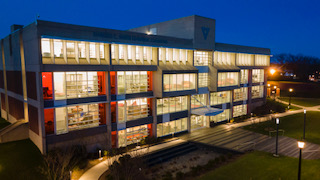
WWI staff and volunteers are inducted as a group to the YMCA National Hall of Fame. Since 1985, 149 individuals alongside the staff and volunteers have been inducted into the Hall of Fame.
TODAY
The YMCA continues to create opportunities for people to improve their lives and their communities. Through empowering young people, improving individual and community well-being, and inspiring action, the Y aims to create meaningful change across the country. In 2021, Suzanne McCormick takes over as the 15th President and CEO of YMCA of the USA, becoming the first woman to hold the position.
Springfield College continues to educate students in spirit, mind, and body for leadership in service to others. Inspired by the Gulick triangle created in 1889, The YMCA Hall of Fame establishes its own brand identity in 2022. Housed on the Springfield College campus in the Harold C. Smith Learning Commons, the National YMCA Hall of Fame continues to honor and feature information about YMCA Heroes who have made an impact on the YMCA community and Movement.
 Ribbon cutting for the newly located National YMCA Hall of Fame. Pictured left to right: Peter Doliber, Dr. Mary-Beth Cooper, Erin Friedman, Harry Rock, Dr. Calvin Hill
Ribbon cutting for the newly located National YMCA Hall of Fame. Pictured left to right: Peter Doliber, Dr. Mary-Beth Cooper, Erin Friedman, Harry Rock, Dr. Calvin Hill
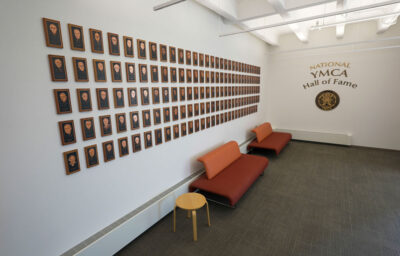
Photo of Learning Commons where the National YMCA Hall of Fame is housed.
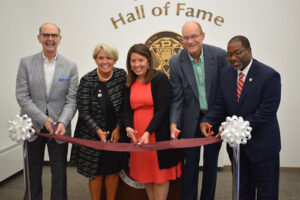 Ribbon cutting for the newly located National YMCA Hall of Fame. Pictured left to right: Peter Doliber, Dr. Mary-Beth Cooper, Erin Friedman, Harry Rock, Dr. Calvin Hill
Ribbon cutting for the newly located National YMCA Hall of Fame. Pictured left to right: Peter Doliber, Dr. Mary-Beth Cooper, Erin Friedman, Harry Rock, Dr. Calvin Hill